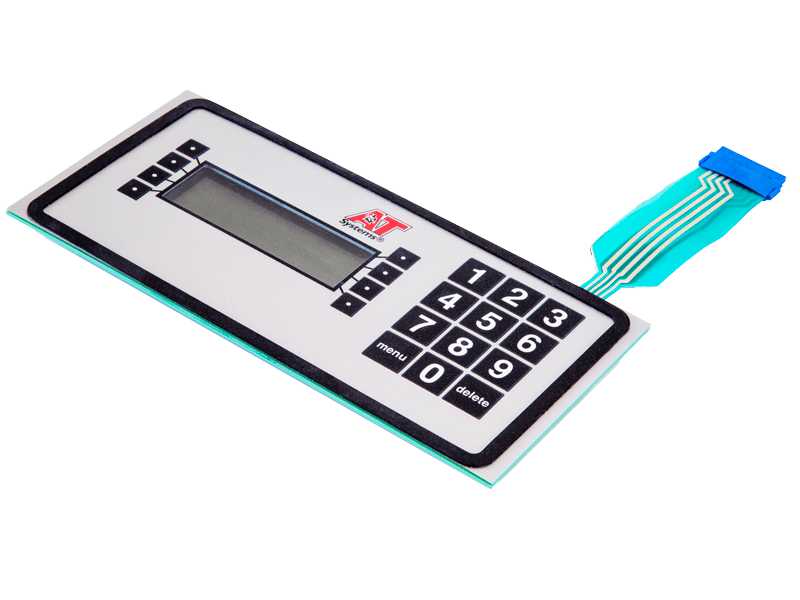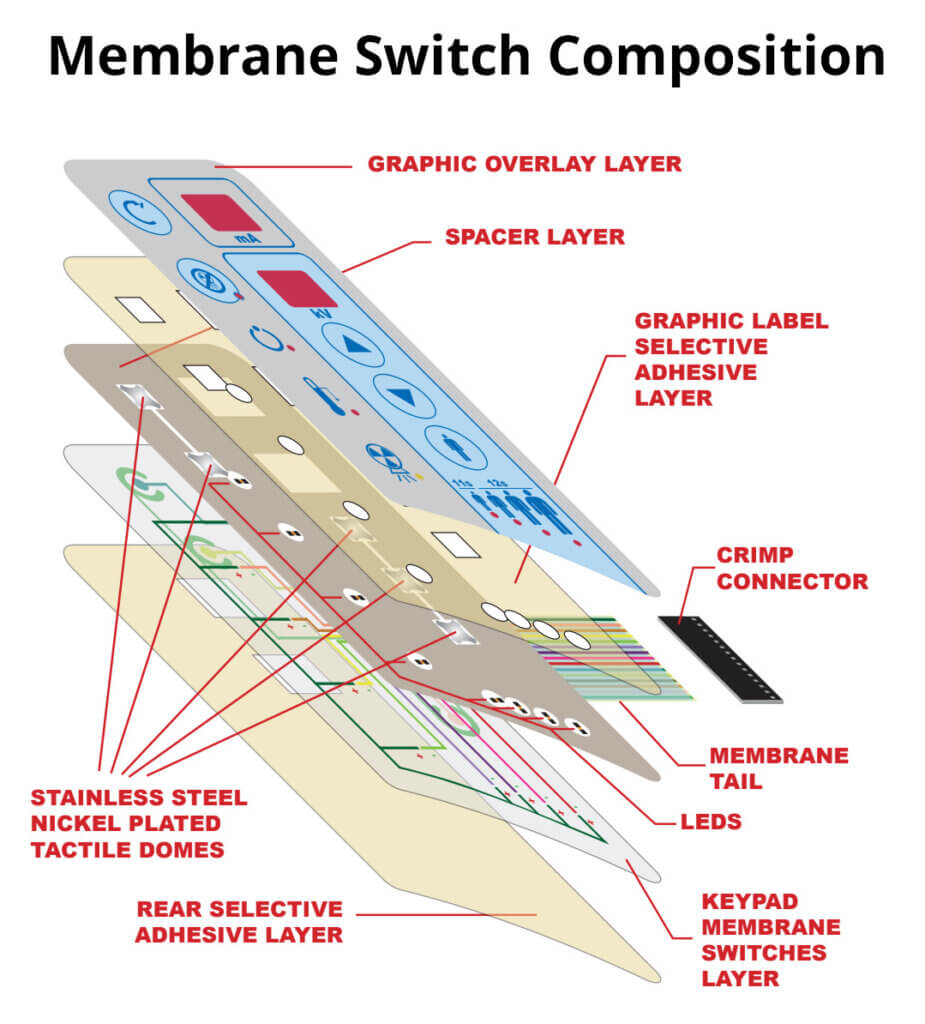Work with a Membrane Switch Manufacturer Dedicated to Quality
Work with a Membrane Switch Manufacturer Dedicated to Quality
Blog Article
Understanding the Importance of Membrane Switch in Modern Electronics and Their Applications
Membrane switches serve as an essential component in modern electronic devices, offering an efficient interface for customer interaction. Their light-weight and adjustable nature makes them appropriate for a series of applications across diverse sectors. Recognizing their vital parts and benefits can supply insights into their growing importance. As modern technology remains to advancement, the development of Membrane switches over increases concerns about their future applications and layout technologies. What lies ahead in this vibrant field?

What Are Membrane Switches?
Membrane buttons are vital components in modern-day electronics, working as interface that assist in interaction in between customers and gadgets. These buttons include several layers, consisting of a graphic overlay, an adhesive layer, and a circuit layer, every one of which collaborate to produce a useful and resilient interface. The style enables a level, low-profile solution that can be tailored concerning dimension, shape, and aesthetic appearance, making them ideal for different applications, from customer electronics to clinical devices. The responsive feedback supplied by Membrane changes boosts individual experience, while their resistance to dirt and moisture makes them excellent for challenging settings. Membrane buttons can incorporate functions such as backlighting and published graphics, even more broadening their use. Their flexibility and effectiveness make them a recommended choice in markets where reliability and convenience of usage are paramount, eventually adding to the smooth procedure of modern electronic tools.
Trick Components of Membrane Switches
While different elements add to the capability of a membrane switch, three primary layers play substantial roles in its layout and operation. The leading layer, generally made from a long lasting polymer, functions as the interface for individual interaction, usually featuring published graphics and symbols. Under this is the spacer layer, which keeps the needed distance in between the top layer and the circuit layer. This spacer layer assurances that the button activates just when pressed, preventing accidental inputs. The circuit layer consists of conductive traces that complete the electric circuit when the top layer is depressed. These traces can be made from numerous materials, consisting of copper or silver. With each other, these components develop a dependable and robust tool that is portable and versatile, appropriate for a vast array of electronic applications, from family home appliances to clinical gadgets. Understanding these crucial elements is crucial for valuing the total functionality of Membrane buttons.
Benefits of Making Use Of Membrane Switches Over

Membrane Switch Manufacturing Process
Recognizing the Membrane button production procedure reveals the complex actions involved in producing these important parts. The procedure usually begins with the layout stage, where specifications and layouts are created utilizing specialized software program. Following this, the visuals overlay is published on a versatile substratum, usually using high-resolution printing methods to assure quality and precision.Next, the glue layers are applied, which offer to bond the different parts with each other. The circuit layers, made from conductive inks or materials, are after that printed onto a separate substrate. These layers are meticulously lined up and laminated to create a useful switch.After assembly, the switches undergo examining to validate capability and longevity. Quality control measures are executed throughout the process to recognize and rectify any type of issues. The finished Membrane switches are packaged and prepared for distribution, all set to satisfy the demands of modern-day electronic applications.
Applications of Membrane Changes in Different Industries
Membrane buttons are progressively used across various sectors, particularly in clinical equipment and customer electronics. In the clinical area, they provide reliable control user interfaces for tools that call for accurate procedure. In customer electronics, these switches improve individual communication by providing responsive and streamlined interfaces. Receptive Medical Equipment Control
Numerous modern-day clinical tools use Membrane switches for structured operation and improved individual communication. These buttons provide a reliable, durable interface for a range of applications, including analysis devices, individual monitoring systems, and medical tools. Their customizable designs permit for particular formats that can suit the one-of-a-kind demands of medical care experts, making sure intuitive navigation and effective accessibility to crucial functions. In addition, Membrane switches are resistant to impurities, making them suitable for sterile atmospheres. The tactile responses they provide can enhance user self-confidence, decreasing the danger of mistakes throughout crucial clinical treatments. Generally, the assimilation of Membrane switches in medical devices considerably contributes to enhanced operational performance and person security in medical care settings.
Consumer Electronics Interfaces
In the domain name of consumer electronics, Membrane buttons play a crucial function in improving interface throughout a wide variety of devices. These buttons are important to products such as remote controls, microwaves, and video gaming consoles, giving a effective and easy to use user interface. Their layout enables a smooth integration of graphics and functionality, making it possible for suppliers to develop streamlined, contemporary visual appeals without compromising use. Membrane buttons are also known for their longevity, commonly withstanding considerable usage and direct exposure to various ecological problems. In addition, they can integrate attributes like backlighting and tactile comments, more boosting the user experience. As consumer demands for innovative yet intuitive user interfaces expand, Membrane switches proceed to be a crucial element beforehand digital gadget functionality.
Design Considerations for Membrane Switches Over
Designing reliable Membrane changes requires cautious attention to numerous variables that affect both capability and customer experience. One important factor to consider is the selection of products, as they can influence toughness, responsive responses, and visual appeal. Picking an appropriate adhesive is necessary for guaranteeing long-lasting bond and resistance to environmental factors.In addition, the format and layout of the switch should suit user communication, with switch dimensions and spacing maximized for simplicity of usage. The consolidation of graphics and labeling must focus on clearness and visibility under numerous illumination conditions.Consideration of electric attributes, such as actuation pressure and switch sensitivity, will certainly improve the responsiveness of the Membrane switch. The design must accommodate manufacturing processes to ensure cost-effectiveness and timely production. On the whole, a well-thought-out design Resources enhances both the functionality and the individual experience of Membrane switches in contemporary electronic devices.

Future Trends in Membrane Switch Technology
As innovation remains to advance, Membrane switches are poised to incorporate brand-new improvements that will improve their performance and application in numerous areas. One significant fad is the consolidation of adaptable and durable materials, which will certainly boost the life expectancy and dependability of these buttons. Improved surface area textures and customizable graphics are additionally expected, permitting more instinctive individual interfaces.Moreover, the integration of wise technology, such as touch-sensitive surfaces and haptic feedback, is expected to enhance individual interaction, making Membrane switches a lot more receptive and engaging. Furthermore, developments in published electronics will make it possible for a lot more intricate circuitry within thinner profiles, even more increasing style possibilities.Sustainability will likewise play an essential duty in future advancements, as producers my website discover eco-friendly materials and production procedures. Generally, these patterns will assure that Membrane switches over stay relevant and important in a progressively digital and interconnected globe.
Often Asked Inquiries
How Do Membrane Switches Compare to Conventional Mechanical Buttons?
Membrane changes deal advantages over conventional mechanical buttons, including minimized dimension, lighter weight, and improved resilience. They commonly supply a sealed surface, improving resistance to dust and wetness, making them excellent for varied applications.
What Products Are Typically Used in Membrane Switch Building And Construction?
Can Membrane Switches Withstand Extreme Environmental Issues?
Membrane switches can endure severe environmental conditions, depending on their layout and products. Top notch constructions typically feature longevity versus temperature variations, humidity, and direct exposure to chemicals, making visit this site them suitable for numerous requiring applications throughout industries.
The Length Of Time Do Membrane Switches Over Typically Last Prior To Failing?
Membrane changes usually exhibit a lifespan ranging from 1 to 10 million actuations, depending on aspects such as use frequency, environmental conditions, and making high quality. Normal maintenance can expand their longevity and functional integrity considerably.
Are Membrane Switches Customizable for Particular Applications?
Membrane switches are without a doubt customizable for particular applications. They can be customized in layout, size, and functionality, permitting producers to meet distinct user needs and improve item aesthetic appeals while preserving functional efficiency and longevity. Membrane switches are important parts in modern-day electronics, serving as customer interfaces that help with communication between customers and tools. The responsive comments given by Membrane switches improves customer experience, while their resistance to dirt and dampness makes them excellent for testing settings. The unification of graphics and labeling must focus on quality and presence under numerous lighting conditions.Consideration of electric characteristics, such as actuation pressure and button sensitivity, will certainly improve the responsiveness of the Membrane switch. Improved surface structures and adjustable graphics are additionally prepared for, allowing for even more user-friendly customer interfaces.Moreover, the integration of smart modern technology, such as touch-sensitive surfaces and haptic responses, is expected to enhance individual communication, making Membrane switches more receptive and appealing. Membrane switches over deal advantages over conventional mechanical buttons, including minimized dimension, lighter weight, and boosted resilience.
Report this page